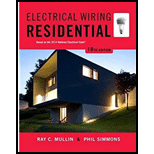
Concept explainers
The Code places a maximum open-circuit voltage on lighting equipment in or on homes. This maximum voltage is (600) (750) (1000). (Circle the correct answer.) Where in the NEC is this voltage maximum referenced? _______________
Trending nowThis is a popular solution!

Chapter 7 Solutions
Electrical Wiring: Residental - With Plans (Paperback) Package
Additional Engineering Textbook Solutions
Thinking Like an Engineer: An Active Learning Approach (4th Edition)
Starting Out with Java: From Control Structures through Objects (7th Edition) (What's New in Computer Science)
Java: An Introduction to Problem Solving and Programming (8th Edition)
Starting Out with Programming Logic and Design (5th Edition) (What's New in Computer Science)
SURVEY OF OPERATING SYSTEMS
Automotive Technology: Principles, Diagnosis, And Service (6th Edition) (halderman Automotive Series)
- Solve this. find the initial conditions ic(0-) and vc(0-) the switch opens at t=0 so it's closed at t=0- dont copy the response from previous because it's wrong. please solve in great detail explaining everything step by step. now the way i thought about it is Getting millman voltage (1/3)-2 / (1/3)+(1/2) and it's the same as Vc as both are nodal voltages but i wasn't sure if correct. because i didnt take into consideration all voltages (Vc here) even though it's the same so i'm quite confused. please explain to me if i'm correct and if not tell me why and where my thinking was flawed. thank youarrow_forward3. Consider the RL circuit with a constant voltage source shown in the diagram below. The values of the resistor, inductor, and input voltage are R = 100, L = 100 mH, and Vo = 12V, respectively. Vo - Ti(t) R w When the switch closes at time t = 0, the current begins to flow as a function of time. It follows from Kirchoff's voltage law that the current is described by the differential equation di(t) L dt + Ri(t) = Vo⋅arrow_forward4. Consider the RL circuit with a sinusoid voltage source shown in the diagram below. The values of the resistor, inductor, input voltage amplitude and frequency are R = 5, L = 50mH, and Vo = 10 V, respectively. The input voltage frequency w is variable. Assume that the circuit has reached steady state. Voejwt + ↑i(t) R سيد The input voltage can be described using the complex sinusoid function V(t) = Voejwt The current is given by a sinusoid with same the frequency was the input voltage, but a different magnitude and different phase. The physical voltage and current are obtained by taking the real part. In complex form, the current is given by i(t) Vo ejwt R1+jw/ The differential equation that describes the current follows from Kirchoff's voltage law, and is given by di(t) L + Ri(t) = Voejwt dtarrow_forward
- 2. (4 marks) Use the real and imaginary parts of ĉejut, where ñ = a + jb = e³, to show that: c cos(wt) = acos(wt) – bsin(wt), csin(wt) = a sin(wt) + bcos(wt). Describe the relations between a, b, c, and o.arrow_forwardCompute the thevenin equivalent between the two terminals a-b zeq and veq show all your steps and explain clearly what you did.arrow_forwardI need help with this problem and an explanation of the solution for the image described below. (Introduction to Signals and Systems)arrow_forward
- I need help with this problem and an explanation of the solution for the image described below. (Introduction to Signals and Systems)arrow_forwardDon't use ai to answer I will report you answerarrow_forwardconpute the thevenin equivalent between the terminals a and b Veq and Zeq note that the voltage source has 5e^j0 V the other values if not clear are -8j 8 20 and 5ohmsarrow_forward
 EBK ELECTRICAL WIRING RESIDENTIALElectrical EngineeringISBN:9781337516549Author:SimmonsPublisher:CENGAGE LEARNING - CONSIGNMENT
EBK ELECTRICAL WIRING RESIDENTIALElectrical EngineeringISBN:9781337516549Author:SimmonsPublisher:CENGAGE LEARNING - CONSIGNMENT
